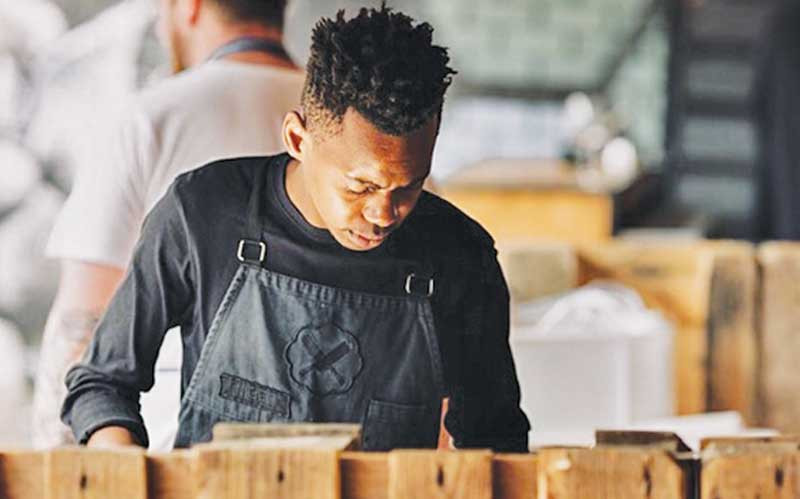
FOOD is the universal language transcending borders and cultures with an incredible capability of bringing people together. From the moment ingredients harmonise to the final presentation of meals on a plate, it takes passion, skill and creativity to transform ordinary ingredients into a culinary masterpiece, elevating a simple dish to being unforgettable.
Newsday Weekender Life & Style caught up with Kupakwashe Nigel Javangwe, a Zimbabwean chef based in South Africa to explore the culinary world and talk about his Shumba 10 out of 10 spices brand, his forthcoming cookbook titled Spices and Herbs and many more things.
Personal background
I was born in Buhera, my mother and father used to work there, but my rural home is in Chivi, Masvingo. I spent most of my time there and had a rural life and food. My father was a teacher, my grandfather as well, so I guess that is where I inherited my writing skills. After Advanced Level I moved to South Africa for tertiary and I studied Information Technology, but as fate would have it I ended up cooking. It is something that I discovered I am passionate about and I wanted to attach my sense of humour and cultural background to my craft.
I am a bundle of energy and enthusiasm, always ready to dive headfirst into new adventures and experiences. Whether it is trying out the latest food trends, exploring the great outdoors or reading a good book, I embrace life to the fullest. But beyond food, I am a curious soul with a thirst for knowledge and love for connecting with people from all walks of life.
Inspiration
The journey to becoming a chef started with a childhood passion sparked by my mother. When I was seven years old she gave me a cookbook for kids as a gift, igniting a flame that would soon turn into a full-blown culinary obsession. She encouraged my curiosity in the kitchen and I remember she let me take charge of making porridge which is my favourite dish.
As I grew older, my love for cooking blossomed alongside my appetite for exploring diverse flavours. I began experimenting with ingredients and techniques, teaching myself the intricacies of culinary arts from a young age. Each dish became a canvas for me to express myself and I relished the challenge of recreating flavours with precision and finesse.
- Javangwe found joy in alchemy of flavours
Keep Reading
With every new recipe learned, my confidence soared and my passion for cooking only deepened. I found joy in the alchemy of flavours, the artistry of presentation and the satisfaction of seeing others enjoy my creations.
Culinary philosophy
My approach to culinary is deeply-rooted in the belief that food is not just sustenance, but a vibrant expression of culture, creativity and connection. With every dish I create, I aim to weave together flavours, textures and techniques that pay homage to diverse culinary traditions, while adding my own unique twist.
Motivation
There is something truly magical about seeing smiles on people’s faces as they take their first bite of a deliciously crafted dish and hearing the sounds of satisfaction and appreciation that follow. Knowing that I have the power to evoke emotions, create connections and leave a lasting impression on people's lives is fulfilling.
Sourcing ingredients
After gaining experience working for an ethical butchery, I learned the invaluable importance of selecting ingredients that are not only of good quality, but also sourced ethically and sustainably. This experience opened my eyes to the profound impact that sourcing practices have, both on the environment and the well-being of animals and communities involved in food production.
Ethical sourcing: I prioritise sourcing ingredients from ethical producers who prioritise animal welfare, sustainable farming practices and fair labour standards. This ensures that the food I prepare is not only delicious, but also aligns with my values of compassion and responsibility towards the planet and its inhabitants.
Quality: I seek out ingredients that are of the highest quality as superior ingredients often result in superior dishes. This means selecting fresh seasonal produce, responsibly sourced meats, seafood and artisanal products whenever possible.
Flavour and freshness: Flavour is paramount in cooking so I carefully select ingredients that are bursting with freshness and flavour. This may involve visiting local farmers' markets, where I can handpick the ripest fruits and the most fragrant herbs.
Frequently used cooking techniques
Sautéing: Cooking food quickly in a small amount of oil or fat over high heat, usually in a shallow pan. This technique is great for vegetables, meats and seafood.
Braising: A cooking technique that involves slowly cooking food in liquids like stocks and wines after searing or sautéing. This method particularly suits tough cuts of meat and fibrous vegetables as it helps to break down connective tissues and tenderises the ingredients while infusing them with flavour.
Grilling: Cooking food over direct heat, either on a grill or barbecue. This method imparts a smoky flavour and grill marks to meat, vegetables and even fruits.
Common mistakes home cooks make
Home cooks may sometimes skim over recipes or fail to read them thoroughly before preparing dishes. This can lead to missed ingredients or steps, resulting in disappointing outcomes.
I encourage home cooks to take time to read through recipes carefully before they begin cooking. They must familiarise themselves with the ingredients, measurements and instructions to ensure a smoother cooking process.
Overcooking proteins like meat, poultry or fish can result in dry, tough or rubbery textures. A meat thermometer must be used to ensure that proteins are cooked to the correct internal temperature. Additionally, leave cooked proteins for a few minutes to allow juices to redistribute, resulting in juicier and more tender meat.
Some cooks also lack confidence in their abilities or have fear of making mistakes which hinder their growth and experimentation in the kitchen. They should embrace mistakes as learning opportunities and not be afraid to experiment with new recipes and techniques. The more you practice cooking, the more confident you will become.
Art of plating and presentation
Eyes eat first. A beautifully plated dish immediately captures people’s attention and sets the stage for a memorable dining experience.
View on traditional dishes
Traditional dishes are the embodiment of culinary heritage passed down through generations and they carry with them the stories, flavours and cultural identity of a community or region. These dishes are a testament to the ingenuity, resourcefulness and creativity of our ancestors who crafted them using locally-available ingredients and cooking techniques.
Modern cooking methods, maintaining authenticity of traditional meals
Respect for tradition and having a deep understanding of traditional recipes and culinary techniques of African cuisines enables me to maintain the authenticity of these dishes. I have respect for the cultural significance of these dishes and the ingredients used, recognising their historical and regional importance.
However, I allow myself room for creative interpretation. Experimenting with modern cooking techniques, ingredients and flavour combinations while staying true to the essence of traditional dishes.
Instead of completely altering traditional ingredients, I consider using local or seasonal substitutes that complement the dish’s flavours and textures. This allows me to innovate, while maintaining authenticity.
Spices and Herbs book
By sharing my knowledge and passion for cooking, I hope to ignite a spark of inspiration in others and help them embark on their own culinary adventures. Because for me, cooking is not just preparing food, it is about nourishing the body, stimulating the senses and feeding the soul. There is nothing I love more than sharing that experience with others.
In the book I shared my knowledge about flavours, nutritional and health benefits of spices and herbs such as the antioxidant-rich qualities of ginger and the metabolism-boosting effects of cayenne pepper to say the least. It is a must-have kitchen essential for home cooks and culinary enthusiasts alike. Packed with practical tips, insightful advice and mouth-watering recipes, the book is an introductory guide to mastering the art of seasoning and spicing.
One of the highlights of the book is a collection of spice mix recipes, carefully-crafted to elevate culinary creations to new heights. From savoury blends for meats and vegetables to aromatic rubs for grilling and roasting, these recipes are designed to add depth, complexity and character to cooking.
Shumba spices
I was driven by a fervent commitment to rectify the prevailing disconnection between consumers and the spices they incorporate into their culinary repertoire. Recognising the pervasive prevalence of processed spices lurking within our kitchens often shrouded in cryptic terminology and potentially deleterious additives, I felt compelled to illuminate a path towards healthier and more transparent alternatives.
Thus, armed with an unwavering dedication to culinary integrity, I embarked on a meticulous exploration of ethical farmers, conscientious suppliers and production methodologies. This endeavour led me to unearth a cohort of purveyors who, like myself, espouse an unwavering reverence for quality, sustainability and flavour.
Drawing upon this wealth of ethically-sourced ingredients, I endeavoured to craft a duo of meticulously curated all-purpose seasonings — one boasting a fiery zest, the other a mellow temperament, yet both resounding with a depth of flavour. Designed to harmonise seamlessly with an array of vegetables and meats, these seasoning blends serve as veritable culinary alchemists.
Through our endeavours, we aspire not to merely tantalise taste buds, but to foster a deeper appreciation for the origins and composition of the spices that grace our tables.
I am eager to incorporate ground mopani worms (madora), a traditional delicacy in many parts of Africa (especially the southern part) among the spice ingredients. These nutrient-rich worms add a distinctive earthy flavour and a satisfying crunch to dishes.
I am also excited to include sun-dried vegetables (mufushwa) which brings a burst of intense flavour and vibrant colour to the mix.
I am passionate about blending these African ingredients with other flavours from around the world to create a truly harmonious fusion of tastes and aromas like cayenne pepper and garlic, which bring their own unique profiles to the table.
By combining these diverse ingredients, I aim to create a versatile all-purpose spice blend that captures the essence of Zimbabwean cuisine, while embracing the global influences that inspire me.
Other cuisines to explore
Chinese cuisine holds a special place in my heart and is one of the culinary traditions that I am most passionate about. Chinese cuisine is deeply-rooted in tradition and cultural heritage, with many dishes and cooking techniques passed down through generations. Food plays a central role in Chinese culture, bringing families and communities together to celebrate festivals, special occasions and everyday meals.
Every now and then I have tried some of their cooking techniques on some traditional dishes to add a bit of a twist to it. At some point I made Szechuan chicken gizzards and sadza.
I love the idea of partnering Zimbabwean brands, even those based in the diaspora such as Kumusha and Mukanya Wines as well as Tapi Tapi Ice Cream. I find their ideas unique, therefore, I attach my brand with theirs.
There was a time I featured on an African dessert programme with Tapi Tapi Ice Cream, a brand that makes ice cream using masawu and mawuyu (baobab seed). I paired up with crumbled Bermuda biscuits and honey for a crunchy feeling. The idea was to curate a Zimbabwean themed dessert.






